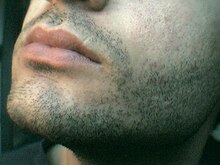Three-day beard
A three-day beard is the name for a beard that is kept very short , with the care and shaving of which only very short stubble are left.
The three-day beard
A characteristic of the three-day beard is that the skin under the stubble still shows through. He has the length of a - subjectively felt - three-day-old beard. The naming is in itself nonsensical, as an individual's whiskers can grow significantly faster or slower. In fact, it can also be a one- or seven-day beard. In addition, a three-day beard is often worn permanently, it then keeps its length by regularly shortening it.
For hormonal reasons, it generally only occurs in adult men .
With stubble is called a renewable or not to the skin surface abrasiertes beard hair before it has the length to conform with its curvature or tilt the growth of the skin and thereby lose his stubby, "prickly" character.
The three-day beard is mostly worn as a full beard , but can also be shaped using various shaving techniques. Electric hair clippers are best suited for shaving, such as long hair trimmers with a so-called beard attachment or special electric beard trimmers .
history
Nowadays, a three-day beard is considered fashionable by many , while until the beginning of the 1980s an unshaven (male) face was still viewed in public as “unkempt and unwashed”. The three-day beard became popular and thus fashionable around 1983/84 through international stars, such as the actor Don Johnson in the television series Miami Vice , or the musicians Sting and George Michael , who both avoided regular (daily) shaving during their concert tours. Another famous bearer of a three-day beard was the politician Yassir Arafat , who, according to legend, trimmed his stubble with a dog razor.
Trivia
literature
- Bernhard Roetzel: The gentleman. Manual of classic men's fashion . Könemann, Cologne 2004, ISBN 3-8331-1060-0 .
Individual evidence
- ↑ Principle: "Dreitagebart" , report by Tobias Kniebe, Süddeutsche Zeitung , weekly supplement magazine , November 17, 2005.
